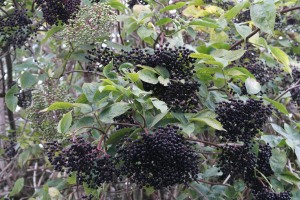
On the autumn equinox we head for the sea. Morning breaks on bold blue skies and whipped cream clouds. Sea and sand sparkle under warm sunlight. It isn’t quite low tide, but wide expanses of reef are exposed. The promenade is full of people, who wander over the causeway to the lighthouse.

The beach is almost empty; the sea flat and far away. The sandscape changes with each tide. Today it is tossed with boulders swaddled in bladderwrack. The sand is studded with lugworm casts and bird footprints. That unmistakeable salt and sweet seaweed scent perfumes the air. The sand martins that nest in the cliffs are gone, but there are flocks of birds out of reach on the reefs. A curlew’s cry echoes. Wind turbines turn slowly beyond the lighthouse and ships break the horizon.

Back on the headland, yellow grass is woven with bronze seed heads. Yarrow and thistle are still in flower. Sea buckthorn berries light up the borders. We sit on the grass and eat ice cream. There are always starlings here and a mob of them soon moves in. At one point there are at least forty, hustling for treats. Once they have decided there is no more, they swarm onto the grass, a sinuous horde, looking for earthier fayre.

The equinox ends with a sky full of storm light. For two days rain falls and winds blow. This is not a summer storm. It is the arrival of autumn. Outside the air seems charged. Damp and rich and full of movement. Though the leaves have barely begun to turn, the atmosphere is bronze. On a day like this, anything can happen. The fire hisses flames for the first time since early spring and the dog lies on his side in front of it. The wind moans in the chimney. The autumn equinox has passed. Summer has fled but the season of magic has arrived.

In the aftermath, we walk to the dene. For a while, our soundtrack is the hubbub of starlings. I wonder if at dusk they join those at the island to murmur into darkness. The sky is moody but dry. A row of linden trees are beginning to curl and brown. Small tree limbs blown off in the storms cover the ground. The sports centre around the corner has become a test centre for Covid 19, a white marquee raised next to the skate park.

A gentle cheep greets our entrance to the dene. Autumn is just flirting here. Crisp bronze leaves lie in clusters; some of the trees are beginning to turn; but green is still the predominant colour. Two wind turbine foundations on their way out to sea jut over the trees. I watch through drooping willows as mallards circle the pond. A pair of black-headed gulls have taken the high perches on the jetty, but one of them is ousted by another before long. The moorhens cry occasionally, the gulls scream.

A clump of meadow cranesbill draws my eye to reeds starting to turn yellow. Sprays of orange lilies and columns of yellow rattle mingle with sienna dock seeds. Tiny fish dart away from my shadow in the burn. The edges are full of berries. Blackberries and rosehips, raspberries and haws, elder and snowberries. A pair of crows feed on a discarded Yorkshire pudding. Suddenly, a feather – grey and downy – falls from the sky, in a slow flight right in front of me. I catch it before it reaches the ground.

On the way home, I notice the weeds between walls and pavement. It has been the year of the weed. Fewer grass cuttings and weed spraying has allowed some to appear that wouldn’t normally be seen and others to grow into monsters.

We may be facing another lockdown. In this area of the country, Covid infections are rising again and there are new restrictions in force. There is tension between those who think the restrictions are too harsh and those who think we aren’t doing enough. We are still fighting for balance as we move into the most challenging part of the year. But this is nothing new. I watch a documentary that describes how the Bubonic Plague in the 14th Century led to revolts and a re-imagining of the world. That plague stayed for centuries, re-appearing every ten years or so to take its toll once more. It feels, right now, like Covid is something that won’t disappear, but that we’ll have to come to terms with.

But for now, the seasons turn. September moves into October and today, it seems, is arrival day. Not long after dawn we walk to the park at the end of the street under an arrow of squawking geese. If that wasn’t joy enough, there is soon more squawking in the air. In the space of ten minutes, five separate skeins of geese fly directly overhead. They are heading south. I wonder where they will come in to land and what they will find there. I am thankful that I was here to witness their passing.












